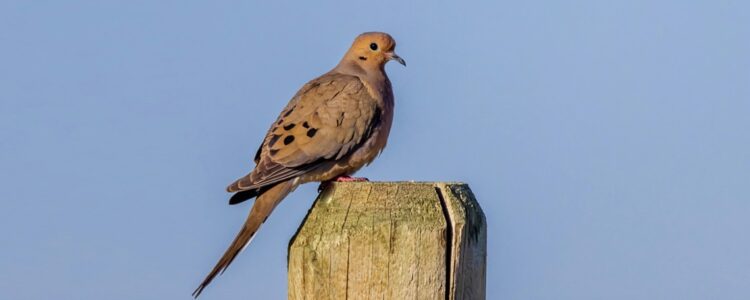
Some hunting trips take quite a bit of preparation and a hefty bank account. In that category are an African safari, wing shooting in South America, or a caribou hunt in Canada. Not so with dove hunting which can be as simple as having a shotgun, some shells, and a place to hunt. Some people will want more and that's okay, but not necessary.
Read on for tips for a successful dove hunt.
Getting started dove hunting
First you need to decide on the what. When considering dove hunting, most people think of the mourning dove. They're small, fast and quite tasty. Their season generally starts on September 1st.
Mourning doves are brown with black spots on their wings and have a long, pointed tail.
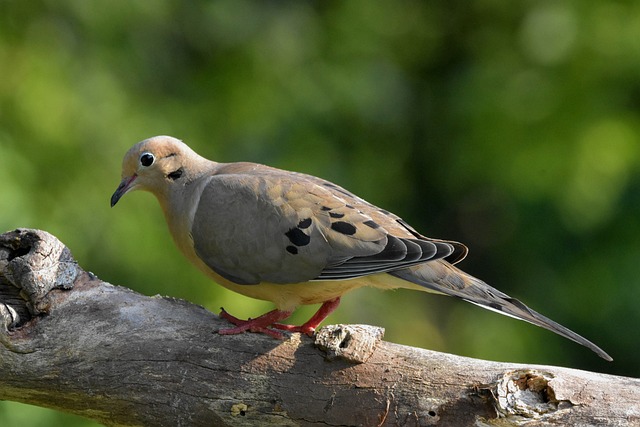
Mourning dove. Image courtesy Pixabay.com
White-winged doves are slightly larger than mourning doves, but they otherwise look very similar. Watch for a white bar on the upper wing surface and a rounded, rather than pointed, tail.
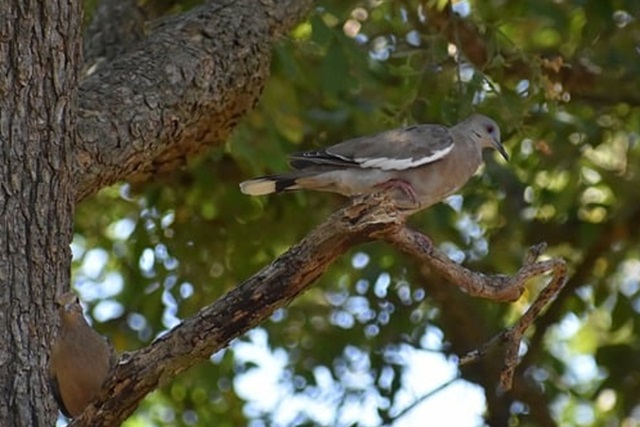
White-wing dove. Image courtesy Pixabay.com
You can hunt both species provided the combined total doesn't go over possession and bag limits.
Another option is hunting the invasive Eurasian collared dove. They're bigger than the mourning dove, have a pale gray body, and a black collar on the nape of neck. Also look for a black bill and a squared tail.
Eurasians are found almost everywhere, and in some states you can hunt them year-round with no limits.
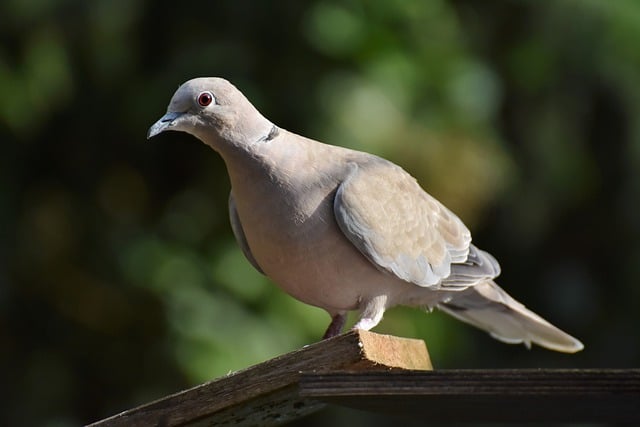
Eurasian dove. Image courtesy Pixabay.com
Next in consideration is the where. Doves need three things - food, water, and gravel. A place to roost nearby is also a consideration.
They love wheat stubble and fields with harvested sunflowers, but any place with seeds can attract them. They'll even stop at ponds with exposed banks and weed cover. Unfortunately many of those places are not available to hunters. Some might be private property and others could be too close to houses.
You can ask farmers if you can hunt on their property. Also check for state-managed fields that are publicly-accessible. Another option is a hunting club. Members can schedule a hunt on the club's property which can be thousands of acres.
Lastly is the when. Mourning dove season starts on September 1 in most states, but check with your state to be sure. Eurasian doves can be hunted year round in some states. There are also other dove species which varies by state. Check state websites or ask for a rule book at your local hunting store.
Dove hunting equipment and gear
Hunting license
Mourning doves are protected under the Migratory Bird Treaty Act so you'll need a valid hunting license with a Migratory Game Bird Endorsement. Every hunter must also enroll in the HIP (Harvest Information Program) and carry proof of enrollment.
Shotgun
Federal regulations require repeating shotguns (pump and semi-auto) be plugged so they can only hold three shells. That includes one in the chamber.
For dove hunting, use an improved cylinder or modified choke for a wider, more open, pattern. A tight pattern makes it harder to hit fast-flying birds, and if you do connect it could tear up the bird.
If you use a double barrel, shoot with an improved cylinder first. Then for a second shot use a modified choke to hit the bird at a longer distance.
Shells
Smaller shot sizes, such as 7, 7-1/2, or 8, are best for dove hunting. These smaller sizes will put more pellets down range which should help you harvest more birds.
Doves are fast and rather acrobatic, so bring more shells than you think you'll need. A good estimate is five shells for each bird you're allowed to harvest, so 75 shells for a limit of 15 birds. Better to have too many than not enough!
Also be sure to check state regulations regarding the type of shot allowed. Steel shot may be required on state land or if you're shooting over water. On private land, ask the property owner if he has a preference.
Clothing
A great thing about dove hunting is you don't need a lot of expensive equipment or special clothing. I usually wear a pair of jeans and an earth-tone or camouflage shirt. Doves seem more concerned about movement than clothing.
If it's a long walk in to your hunting spot, make sure your boots are well-fitting and broken in.
Wear a bird vest, preferably in blaze orange for your safety in the field.
Eye protection
Rose or amber-tinted glasses will protect your eyes from UV rays and stray birdshot. They also improve your depth perception so you can separate targets from the background.
Hearing protection
This is a must-have. One unprotected gunshot can cause significant damage to your hearing. And once your hearing is damaged, it can't be repaired.
There are a variety of options available from the disposable foam earplugs to custom fitted hearing protection. Learn more about the options for ear protection in this Complete Guide. Choose what works best for you.
Sunscreen
Although a lot of other hunting seasons are in the cooler months, dove season is often warm and sunny. Be sure to apply sunscreen on any unprotected skin.
Water
Bring enough for you and for your dog.
Beyond the must-haves, here are some nice-to-haves
A trained retriever
A well-trained dog can make your time in the field so much easier. When my friend, Tom, and I hunted along a creek bed the birds seemed to know where we were and took a detour. So I sent my Lab up on the bluff to the west of the creek.
She not only handled her main duty of fetching the birds we shot, but also worked as a "traffic cop." Her presence on the bluff had the birds flying along the creek bed and very near to us.
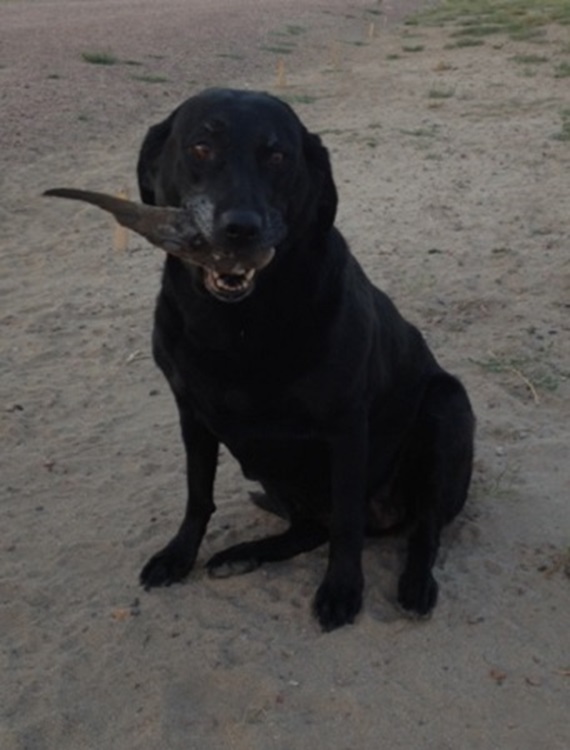
Having two dogs retrieving got the birds out of the field quickly. They also made it possible to find downed birds where the grass was thick and deep. However you must be aware of where each dog is at all times. In thick cover you might add a bell or beeper to their collars.
The best dove hunting dogs are trained well. Skills needed include:
- steadiness
- marking ability
- familiar with gunfire and whistle commands
- experience retrieving upland birds (very different from waterfowl).
If your dog hasn't hunted doves before, set up a mock hunt that simulates what the dog may experience. If you normally fill your 15 bird bag limit, do a lot of shooting & retrieving. Or if you usually only see a few birds then include lots of sitting and waiting.
Safety tips for dove hunting with a dog
If your dog is young and/or inexperienced, know that your attention will be divided. If he's not rock solid steady, keep him on a leash while anyone is shooting.
Because it's often quite warm during dove season, make sure your dog doesn't overheat. Provide water and as much shade as possible.
Also be aware of potential dangers in the field, such as snakes, barb-wire fences, holes, and snags. Several years ago there was a fast-moving dog that hit a hole, somersaulted, and broke his back.
Your dog's safety is more important than shooting another bird.
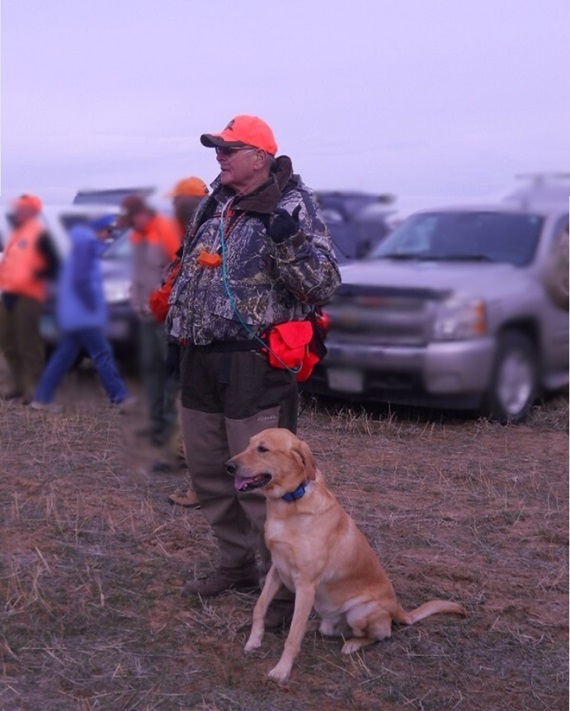
My good friend, Tom, and his yellow Lab, Woody.
A bumper for your dog
Sometimes the birds just don't cooperate. When that happens, toss the bumper for your dog to retrieve.
Forceps
Walking in to our spot on the creek required crossing a large patch of yucca and prickly pear cactus. The dogs were excited to go, but not so happy about the stickers. Before our next hunt we bought some forceps to pull the spines without pricking our fingers.
Other suggestions I've heard are to brush white glue or rubber cement over the stickers, let it dry and peel off. Using duct tape may also help.
Decoys
Doves respond well to decoys and they're not that expensive. Cabela's offers some sets of 4-6 decoys for $20-30. Motorized decoys will cost $50 or more, but it's worth the expense as doves decoy to them from a distance.
For a really inexpensive DIY set of decoys check out the article from Colorado Outdoors Magazine. Then use some clips to attach them to fencing and branches.
Blind to hide behind
Where I hunt there are lots of trees to hide behind so I don't bring a blind. I do have a small one I made out of gunny sacks and a couple of hot wire poles in case I ever need it. But if you'd rather not DIY there are plenty for sale online.
Something to sit on
Depending on how far you have to hike in, you may want something to sit on or decide it's not worth the trouble.
I like a bucket with a cushioned swivel top. It makes it easy to carry what I need including ammo, water, sunscreen, and plastic bags.
Knife or game shears, resealable bags, and an ice-filled cooler
Everyone has their own way to field dress doves, but it's important to get them cooled down as soon as you can. I put them in a bag and pop them in the cooler until there's time to dress them out.
Once the action slows down, I'll pluck the breast feathers and peel off the skin. Then cut the breast from one of the wings, leaving a fully feathered wing attached. It's quick, easy, and few feathers are left to fly around.
Other people will pluck the entire bird after removing the head, feet, wing tips, and entrails. The trick, they say, is to pluck the birds while they're still warm. Just remember you may need to prove the bird's species. The easiest way is to leave a fully feathered wing attached.
Preparing for your hunt
Even if you have a favorite spot, check everywhere you might hunt in the coming season. Something about the location might have changed causing doves to avoid it. Land ownership could have changed as well.
Drive around areas that doves might like. Look for birds sitting on power lines near croplands or flying in or out of a field. Watch for doves on gravel roads where they can consume grit to help digest their food.
Although their natural foods are sunflowers, foxtail, and grasses with small seeds, they are also attracted to croplands.
Also look for a water source nearby. In warm weather doves will fly to water several times in a day. The water can be as small as a puddle, but look for water that doesn't have a lot of vegetation around it. Doves are more vulnerable on the ground and prefer a good field of vision.
When you find a likely area, ask the landowner for permission if it's private property. Or if it's state land, check the regulations.
You might also try contacting the local conservation officer. He may know of food plots planted for upland game on state lands. Or he could suggest landowners for you to contact. If the landowner gives you permission, you should thank him with at least a note or a few birds you shot on his property.
Hunting methods
Pass-shooting
Doves like to feed in the early morning and in the afternoon. If you're in the right place at the right time, you'll see them moving from feeding ground to water and then to roost. During the middle part of the day, they'll mostly hang out on power lines or in trees.
Things to keep in mind:
- Doves like to be part of a flock. If you see a few birds, wait a bit to see if others come along. Watch where they go. Look for a place along that flight line where you can set up.
- Best times to see doves are just before sunrise and about an hour before sunset. In the morning, they're heading out to feed. In the evening, they're going to get a drink.
- Pay attention to the prevailing wind.
- Look for a place where you can blend in, rather than being silhouetted against the skyline. And then stay still while birds are flying.
- As seed eaters, doves will walk around on the ground looking for seeds. And they prefer open ground so they can see approaching danger.
- They also want to be fairly close to water. Generally they'll eat in the morning and afternoon, then get a drink, and finally head for a roost.
- Another place to check are areas with sand or gravel. Doves will visit these areas after feeding because they need grit to grind down the seeds.
- Doves are fast fliers so you need to aim where they'll be and not where they are. Focus on the bird's head and add a four to six foot lead. Increase or decrease the lead until you find your sweet spot. Be sure to continue swinging through the bird as you shoot.
Decoying doves
Doves will decoy. One or two spinners can be seen from a distance and will bring doves in close. Wing flapping decoys look more natural, but can't be seen as far.
Adding some static decoys set out to look like they're feeding, drinking, or roosting will help incoming birds think it's safe. Just make sure the decoys are easy to see.
Even silhouettes clipped onto tree branches and fences can work.
However when shooting over decoys, be aware that your shots may be lower. What can be hit with a low shot? A building? Other hunters? A dog?
Regulations
Be sure to read a copy of your state's regulations.
You can't hunt over an area where "bait is present that could lure or attract birds 'to, on, or over areas where hunters are attempting to take them.'" So watch for grain or other feed in the area where you plan to hunt. If it's due to agricultural planting and harvesting, you should be fine. However if the grain is in piles, you should find another place to hunt.
Some tips from Arizona Game & Fish:
- Don't shoot within 1/4 mile (440 yards) of an occupied structure while hunting unless you have permission
- Don't shoot from, across or into roads or railways
- Don't leave shotgun shells or other litter on the ground
- Don't hunt over water all day — allow time for livestock to access water
- Don't consume drugs and/or alcohol while hunting or handling firearms
Terms you should know
"Motorized vehicles. You cannot hunt migratory game birds from or by means, aid, or use of any motor vehicle, motor-driven land conveyance, or aircraft (if you are a paraplegic or are missing one or both legs, you may hunt from a stationary car or other stationary motor-driven land vehicle or conveyance).
"Shooting hours. You cannot hunt migratory game birds except during the hours open to shooting.
"Closed season. You cannot hunt migratory game birds during the closed season.
"Daily bag limit. You can take only one daily bag limit in any one day. This limit determines the number of doves you can have in your possession while in the field or while in route back to your car, hunting camp, home, or other destination.
"Wanton waste. You must make a reasonable effort to retrieve all doves that you kill or cripple and keep these birds in your actual custody while in the field. You must immediately kill any wounded birds that you retrieve and count those birds toward your daily bag limit. Your birds must remain in your possession while in the field. You cannot give your birds to another person in the field regardless of whether or not they are properly tagged.
"Tagging. You cannot put or leave migratory game birds at any place or in the custody of another person unless you tag the birds with your signature, address, number of birds identified by species, and the date you killed them.
"Dual violation. A violation of a State migratory game bird regulation is also a violation of Federal regulations.
"Migratory Bird Harvest Information Program (HIP). Each hunter is required to enroll in the HIP and carry proof of such enrollment.
"Protected birds. Federal law prohibits the killing of non-game migratory birds. Protected birds that you may encounter while dove hunting include songbirds, eagles, hawks, owls, vultures, killdeer, nighthawks, herons, egrets, and woodpeckers."
After the hunt
Care for your dog
Run your hands over your dog's face, ears, body, legs (including "arm pits" and groin) and between his toes. You're looking for injuries, bumps that could be ticks, foxtails, and cactus or other stickers.
Be sure to offer water as well.
Finish prepping birds
If you've already started preparing your birds, just cut off the remaining wing and clean the breast. Otherwise finish preparing your birds whether you'll cook the entire bird or just the breast.
I like the time-tested recipe - wrapped in bacon with a slice of jalapeño. Although I admit I like a milder pepper and often use a poblano instead.
Doves are tiny but tasty. The breasts are dark red meat that tastes like beef, or like little duck breasts, if you cook it rare. Breasting a dove is simple and takes seconds, leaving you with about an ounce of meat per dove. You can leave the meat on the keel and make the ever-popular dove popper, a cream-cheese and jalapeno-stuffed breast wrapped in bacon, or you can filet those two bites off the breast and use them in a kabob or stir-fry. And, again, the meat will be delicious rare, and unpleasantly liver-like if you cook it too much.
If you'd like something a little different, check out Hank Shaw's dove recipes.
Final thoughts
Dove are quick, fun, and tasty. I look forward to September not only as the start of hunting season, but also for soon-to-be cooler weather.
Enjoy your time in the field, whether it's with hunting buddies or just your favorite dog.
Header photo by Aaron J Hill/Pexels


